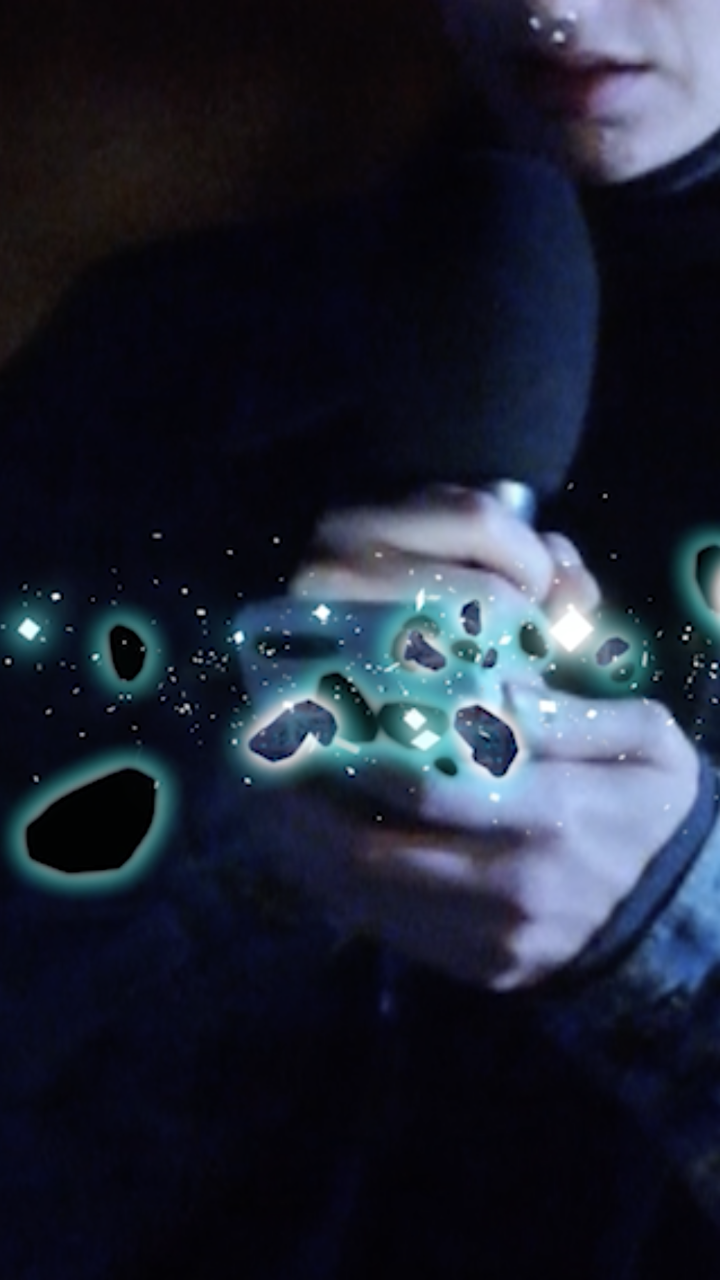film stills
































solo project at the CAC Centre Art Contemporain, 1 - 31 March 2019, 5th floor.
Curated by Francesco Urbano Ragazzi.
Molecular Ghosts of Love by Johanna Bruckner alludes to a new possible level of exchange in the vertical world of transactions. The return of affections in a codified environment. A digital effect surrounds the bodies of a group of dancers, protecting and polluting them like an atmospheric dust. Like a new face filter, a body filter. The ghost filter. Yet this dust are the those particles that are alluding to a new internet. With Six Doors, the curator duo Francesco Urbano Ragazzi presents six videos that explore the materiality of images and the fundamental reorientation from horizontal to vertical now conveyed by social networks.
This work is based on Bruckner’s research on post-monetary value production. New cryptocurrencies work on the basis of gift exchange and mutual dependencies and their tokenless value productions are equivalent to the operation of affective forces. What kinds of affective zones are we capable of producing in the future via new technology and how can their values be redistributed? How can gift giving become a polymorphic structure of mutual support, which alters the exchange based forms of gift giving as economic instruments; and capital’s exploitation of our desires with affects‘ potential of indeterminacy? Can we think of gift giving as polymorphic movements in order to acess these new infrastructural transformations and their manifestiations as queer ecologies? The video’s sound track supports these propositions to become tangible.
Long text by Johanna Bruckner
These elementary reflections are first propositions on how recent conceptions on the molecularization of the world and our bodies may crystallize in a redistribution of the sensible. How can today’s collapse of space and time enact particular situations of molecular revolutionary scenarios; ones which allow of the re-ordering of today’s biosurveillance regimes in favor of a micropolitics of the sensible? Which affectively diffracted temporalities are needed for bodies to align beyond the boundaries of language? And more precisely, which virtual body conceptions are needed, in which matter, energetic materials and volatile things coexist with humans in non-hierarchical intra-actions and entanglements? The starting premise for these reflections is that matter, be it material of affective, is having self-agential capacity, intrinsic self-transformative potential and is in constant metamorphosis within itself and toward the other with whom it is in a constant affinity; being a desirous and energizing dynamism of polymorphic sensible relationalities. In the following, when the molecular appears in relation to certain significations, let me underline that it is in general about abstract force of the molecular in as such, which is a floating synthesis of plural encounters.
1.
The present moment can be understood in terms of the collapse of space and time. We are witnessing a set of political and economic transformations, such as the increasing liberalization of markets, the unprecedented mobility of knowledge and capital, the extension of global supply chains, the transformation of ecosystems and the growth of planetary sharing and attention economies, all of which have implications for the human’s presence within the world’s changing political configurations. These new economic and social orders have particularly benefited from advances in molecular biology, immunology, virology, biosociality- and genetic citizenship research which have been valorizing the human body as a molecular body and have commercialized their affections as biochemical and geopolitical matter. Biological substance, for example, is translated into fluid networks of information while opening up new circles of capital and intellectual property. The Internet provides novel possibilities for the sharing of biomedical knowledge to foster the surplus of biovalue. Gene-discovery software allows to encode biological materials; nanotechnologies guide the making of in/organic objects. Chemical industry, atomic energy, as well as speculations in the automation of human feelings have placed the bodies’ desire in an ensemble of social relations, in which the libidinaly economy serves the sex design of pharmpornographic bio-capitalism. Thus, the molecular is to be understood by two trajectories of the present; that of, one can say, neoliberal forms of settler colonialism and financialized capital accumulation.
In this global economy of exchange and circulation the body is thrown into a chaotic and unpredictable molecular world. With the biochemical modification of sensibility (Preciado) the body is continuously subject to speculative alteration.
These new bodies of biovalue are moreover disciplined under the age of biosecurity, in which life itself regulates matter, and controls it through the interconnected techno - and geopolitical apparatus of risk technology. As such biosecurity only invents the subject as molecular valuable entities.
Through these exploitations of intimacies as data, today’s bodies of biocapitalism are nonetheless endless precarious subjects. If we conceive of these molecular bodies as composite entities of speculative and technical interests, research into the molecularization of human existence becomes a matter of ethical and political concerns.
In the following I will briefly reflect the molecular from the perspective of labor, because in the dialectic between accumulation and immiseration the molecular constitutes specific autonomies, which are necessary for understanding these sketches on the redistribution of the sensible.
2.
With Paul Preciodo, the capacity of “molecular joy” represents the raw material of what post-autonomia thinkers refer to as cognitive capitalism. Stimulated by the dissolution between labor, life and leisure; as well as the private and the public, the valorization of desire as semiotics have liquefied work. Today’s regime of cognitive labor depends on the technologies as machines of desire, which produce affective experiences as systems of labor. Labor is the semiotic reproduction and valorization of life. Such desiring machines are, according to Guattari, the so-called microphysics of the unconscious; and never exist independently of the historical molecular aggregats, of the macroscopic social formations that they constitute. Thus, if we conceive the structure of affection/being affected, according to Mc Kenzie, not as an appropriative strategy, but view it as a metamorphosic virus, it may be catalizing motor to break with the extractive dependencies, and capital’s exploitation of our desires right with affects‘ potential of indeterminacy. To break with one’s estrangement within the social mechanisms of alienation.
At the heart of every disciplinary machine of labor, as well as of every surveillance system, to continue, a certain type of micropolitical virus is at work, which infiltrates the configuration of abstract machines. Accordingly, as the way we behave in relation to technologies is not simply automatic but rather a continuous area of friction, an emerging political subject of desire is emerging in this process of «disaffected labor». Drawn into a mutual state of affection it constitutes itself via assemblages of micro-revolutionary crystallizations, whose intensifications conceive of the techno-human bodies as «particles of possibility» (Barad). Our technological machines – or, «abstract deterritorialisation machines» (Guattari) - constitute ourselves in relation to matter that surrounds us. The politics of desire essentially concern these assemblages of «particles of possibility» that abstract machines constitute. There is, then, no struggle for justice but only the construction of sensible assemblages at every level of the desiring machines. So, todays technoid body of the sensible - which is a body whose boundary between human and machine is constantly displaced - can be conceived as, with Haraway, «a matter of material imploded entities, a body as dense material semiotic things; in between and not able to locate». Their state of indeterminacy is the making of new temporalities, spheres of desire, in which new subjects of entanglements come into being. I now want to more deeply elaborate on these subjects of diffraction, one may call them with Barad, that characterize the contemporary moment of sensible bodies.
3.
Subjectivities and their social relations are structured through pre-personal or inhuman forces - forces that are constructed as competing microagencies. These subjects are bodies of multiplicities, because they are diffracted across spaces, times, realities and imaginaries. Conceiving of these processes as Agential Realism, Karen Barad proposes that phenomena are simultaneously material and discursive and are constantly reproduced by a material-discursive intra-action. The body here is a situated actor that continuously changes and relocates itself in the interaction of materiality and meaning, of matter and discourse. This embodiment is to understand its situational embedding in the environment as well as its interaction with it – as an embodied cognition.
To understand this corporeality of matter and desire, Karen Barad follows quantum field theory and proposes that “matter is characterized by self-touch - by the interaction of the particle with the surrounding electromagnetic field or virtual particles, which it itself generates and destroys – and in which it ‘comes into contact with the infinite alterity that it itself is’”. Touching and experiencing is thus the essence of what constitutes matter. This concept of matter always included alterities, the virtual, the unpredictable, and thus requires “recognition of our responsibility towards the infinity of the other”. In this regard, the sensible itself is in continuous intra-action with itself, and therewith, queering, disordering preempting affections, or the affective self. This understanding of the indeterminacy of the self, as multiplicity, is with Barad, a superposition – an intensification of matter beyond an ordering regime.
But what are the forces for these virtual textures of superpositions, of the particles relating, forming and breaking matter as intra-actions? Barad here introduces the concept of «agential separability». Material enactments are in the process of differentiating in conjunction with affective forces, which keep the object-human relation in the process of continuous de-and refracting. Agential separability, the agentially enacted material conditions of phenomena is what shapes and reshapes matter from within.
Thus, there are micro-agencies within the matter-human relation on the smallest scales, in any particular situation, which lead, in their intensifications on a larger scale, in response to Guattari, to micro-revolutionary crystallizations. Accordingly, Barad puts forward that “phenomena are not located in space or time, but they are material entanglements enfolded and threated through the spacetimemattering of the universe”. These agential cuts, the micro-revolutionary formations enact the possibilities of responses, situational responses, which indeed produce capabilities of responsibilities through every particular constellation of particles. A microrevolutionary practice presupposes plural acts of becoming responsible/response-abilities. Matter, thus, is a «densification of the ability to react, to respond».
4.
The molecular is exploited as raw material but may be, at the same time, an immediate available resource for resistance. Exemplifying this argument, with Preciado, on basis of testosteron, it is precisely the embedded social ontology of testosterone itself, such as its heterogeneous production apparatus of both, human and non-human capacities, which exceeds the practices of simply consuming it; thus troubling the fact of alone being raw matter for biocapitalist valorization. The revolutionary immediacy of molecular agency, is intrinsic to the non-human domain of cells, metabolic networks and protein folding, among others, which offer resistance to the capitalization of biovalue. Furthermore, Thacker’s concept of the autonomization of cellular life supposes that reproductive work is not only cellular reproduction but at the same time the autonomization of cultural and affective reproduction of life.
Serveral instruments that valorize the molecular body on a financial level produce, to repeat, precarious bodies. The precarious body is not only characterized by the molecularization of labor and the appropriation of desire, exploited on the semioticization of intimacy. It is being shaped and reshaped at the molecular level by reconfiguring the cellular processes and their multiplications by themselves. At the same time, these multitudes of molecular bodily materials, as sensible relationalities, provide space for the proliferation of alternative body-knowledges, for the emergence and organization of new demands on state and capital by the collectivisation of semiotic-sensible minds; as for today’s cognitive workers the biological self is a precarious bare entity.
Moreover, the regimes of financial valorization and biosecurity are rather instable and fragile state of affairs, as it is difficult invent an ‘unspecifiable’ future-to-come within the molecular realm of economic calculation. With Barad’s approaches on matter’s capability of intrinsic micro-agencies, the virtual is in fact incalculable. Thus, it means for us to actively intervene within the disorder of biological life in order to produce present and future temporalities of collective desire, affinities and entanglements. It would seem that our most pressing need is a political order that corresponds to these corporeal technoscientific practices; one that is not determined by investments, or constrained by law, property and nation, but is open to an ontological and ethical play beyond the current appropriation of life into the geopolitical biological apparatus.
In Fred Moten’s social conception of the molecular it is about the “sub-ontological zones, in which confrontation and struggle take place outside the field of the recognizeable and representation itself”. Through for example, practices of aligning via molecular strategies undercommon-ing etc., it posits the world as yet to come – thus conceiving the present as an open field of political engagement. This molecular territorialization can now refer not just to chemical and genetical processes but also to human bodies and political groupings and assemblages. «Molecules territorialize and deterritorialize by creating ever-new groupings and then branch off into other possibilities (Guattari)». Matter may appear to free itself from the subject and drive toward unpredictable, aleatory (queer) relational newness. The herewith emerging molecular temporalities, speculatively spoken, generats a discontinuous history and present of its own.
Referring to an example, in afrofuturist micropolitical explorations of the condition of becoming alien through technology, the affective modalities of becoming human are set against new forms of emerging life. Technology’s «human-machine» interface (Eshwun) abstracts race through polymorphic alignments, encoded as information patterns, in order to create new possibilities of life out of the urban alienation. A molecularized conception of race as post-race, allows a modality of politics of condagion between technological advancement and socio-cultural phenomena. (This paragraph is subject to further elaboration, here or elsewhere).
Matter’s ongoing constitution of the sensible as molecular, intra-active patterns are queer ecologies because their inherently resistant nature, through their aleatory figuration, the molecular becomes an abstraction. Those molecules of desire become the occasion for polymorphic anticipation, affect as joint possession and embodied microagencies of the sensible.
sound emphasis
text emphasis